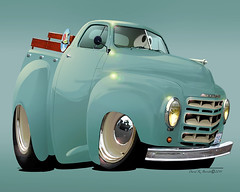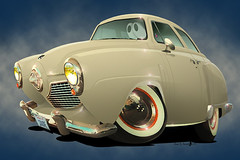This interesting device probably dates from the 1940s or 50s. It was not a genuine Studebaker accessory but an aftermarket item sold thru Snow Plastics Corp. of Chicago. The gauge was mounted on the instrument panel and the nipple at the bottom was for a vacuum hose that connected to the carb (or manifold). I am guessing that these were made available for other makes (with names on the dial). I had a Cadillac Eldorado back in the '90s that had a similar feature though it was built in. I believe it worked on the same general principle. I suspect most other manufacturers had similar devises at various times. This is the only one of these I have ever seen.
Announcement
Collapse
No announcement yet.
#5 Studebaker collectibles (mpg gauge)
Collapse
X
-
#5 Studebaker collectibles (mpg gauge)
This interesting device probably dates from the 1940s or 50s. It was not a genuine Studebaker accessory but an aftermarket item sold thru Snow Plastics Corp. of Chicago. The gauge was mounted on the instrument panel and the nipple at the bottom was for a vacuum hose that connected to the carb (or manifold). I am guessing that these were made available for other makes (with names on the dial). I had a Cadillac Eldorado back in the '90s that had a similar feature though it was built in. I believe it worked on the same general principle. I suspect most other manufacturers had similar devises at various times. This is the only one of these I have ever seen.Richard Quinn
Editor emeritus: Antique Studebaker ReviewTags: None
-
That's pretty cool, Richard. Somewhere around here I've got a less fancy one that still has it's original box. On the box is featured a bathtub Nash. That probably dates it pretty well.No deceptive flags to prove I'm patriotic - no biblical BS to impress - just ME and Studebakers - as it should be.
-
I have had several modern vehicles with digital readouts that give MPG readings. They give supposedly "real-time" readings depending on whether you are accelerating, coasting, or pulling hills, and another reading that gives "average" MPG. Although they are computer controlled, there must be some mechanical sensors and "interface" with mechanical conditions to give this information. I have always surmised that the readings are compiled from a combination of fuel flow, oxygen sensor, manifold vacuum, etc.
I wonder how much more accurate these digital readings are over the vintage analog gauge.John Clary
Greer, SC
SDC member since 1975
Comment
-
The first new car my Dad ever purchased was a '63 Grand Prix...it had the vacuum gauge on the console. If the car was equipped with a manual transmission it came with a tach in that location in place of the vacuum gauge. That beautiful car only lasted 2000 miles before it was demolished in a head-on.Originally posted by showbizkid View PostFor most of the '60s, Pontiac offered a factory quarter-sweep vacuum gauge in a 3" chrome "bullet" that mounted to the console in sportier models (LeMans, GTO, 2+2, etc.). But I've never seen one calibrated in MPG before! This is a cool find!Poet...Mystic...Soldier of Fortune. As always...self-absorbed, adversarial, cocky and in general a malcontent.
Comment
-
Stewart-Warner used to make a vacuum guage called a "motor minder". I still have one somewhere but I think in addition to inches of vacuum on the guage it also had an "estimated gas mileage" feature. It illustrated the benefits of keeping a light foot on the pedal to incrrease mileage. Never helped me much though.
Comment
-
Digitall MPG gauges
"". Although they are computer controlled, there must be some mechanical sensors and "interface" with mechanical conditions to give this information. I have always surmised that the readings are compiled from a combination of fuel flow, oxygen sensor, manifold vacuum, etc. ""
Back in 2003, I flew into Salt lake City, rented a car, stayed a few days, then drove to Reno. I needed a large car as we were meeting some friends at the airport in Reno. My preference was a Crown Vic or the like and nothing like this was available at SLC, so the counter-bot asked if I'd like a Cadillac. Thinking it was something like a CTS I hesitatingly agreed, but in the yard I was steered toward this Land Yacht.... a Sedan DeVille.
Leaving the airport the mileage meter said 11 MPG. I was a bit nervous, as this was the year that gasoline was to hit $4.00/gal. We babied the car around town for a few days, then headed out on I-80. I wasn't pressed for time, so didn't exceed 60 and was routinely getting bleeped and passed on the long straight stretch toward Bonneville. As we progressed, that MPG meter went from 11-13...14.....18....20...22... When we got close to Wendover, the dial was reading "33 MPG" and I wanted to gas up, as we had been driving a bit over 2 hours. I thought the gauge was erroneous, but to my surprise, the tank only took around 3.5 gallons.
I thought that was the best secret that dumbass GM ever kept to themselves. A 5000 pound Caddy getting that kind of mileage was quite a treat. After that we picked up on the speed and still got around 28...64 GT Hawk (K7)
1970 Avanti (R3)
Comment
-
The manuals for my '86 tbird show the optional digital dash (so cool 80s!, hehe). The MPG could be displayed amoungst other things. That setup DID have a fuel flow meter in the fuel line. The dash display was completely separate electronics from the engine computer so the flow meter was needed along with the OD as inputs to the dash to calculate it.
Nowadays, the MPG is calculated by the engine computer and the info sent over a communications data link to the dash or its also available at the diagnostics connector. There are aftermarket MPG gauges if your vehicle doesn't have a dash display that plug into the diagnostics port. The MPG is calculated from the fuel injector ON times. The fuel pressure is regulated (and usually also monitored by the computer with a sensor). The fuel flow rate for the injectors is known for given pressure so the total flow is simply the percentage of ON time per engine cycle vs the flow it would have if 100% on. Then the MPG can be calculated from that with the OD counts.
I think the reason they didn't do it that way in the 80s (should have been possible) was the engine computers weren't powerful enough to do the added bells and whistles stuff as well as the basic engine functions.
Jeff in ND
Comment
-
I wonder how much more accurate these digital readings are over the vintage analog gauge.
I'm not at all conversant with the vintage equipment, but my '05 Subaru runs a consistent 5.6% generous on the average mileage. I know that if it says 31.5, its really getting 30 mpg. It will better than if I keep it at 65 on the interstates, but who can do that!
Comment




Comment